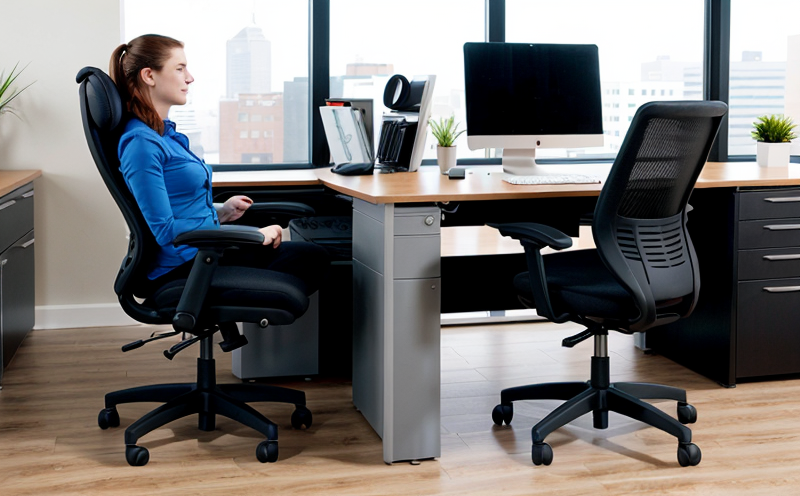BS EN 1022 Stability Testing of Office Seating Units
The BS EN 1022 standard is a critical component in ensuring the safety and reliability of office seating units. This test evaluates the stability of these units under various loading conditions, thereby preventing accidents that could result from instability or collapse.
Office seating units are designed to support individuals for extended periods, often in demanding working environments where comfort and ergonomics play a significant role. Stability is one of the paramount factors in determining the safety and usability of such furniture. Instability can lead to potential risks including injury due to falls or structural failure during normal use.
The test procedure outlined in BS EN 1022 involves applying specific loads at defined angles, which simulate real-world usage scenarios. This ensures that any design flaws or material weaknesses are identified early on, allowing for necessary improvements before the furniture reaches end users. The stability of an office seating unit is not just about holding its shape; it's also about maintaining structural integrity under stress.
Understanding the purpose and significance of this test requires a brief overview of what constitutes stability in an office seating unit. Stability can be broken down into several key components:
- Load Capacity: The maximum weight that the seating unit can support without compromising its structural integrity.
- Angle of Stability: The degree at which a load is applied to determine if the unit remains stable. This angle simulates how users might interact with their furniture in various positions and movements.
- Load Distribution: How evenly the weight is distributed across the seating surface, ensuring that no single point bears an excessive amount of pressure.
The BS EN 1022 stability test ensures compliance with these parameters by subjecting office seating units to rigorous testing. This process involves precise measurement and recording of how the furniture responds under various loading conditions. The results provide valuable insights into the design, materials used, and overall quality of the product.
For a better understanding, let's delve deeper into the specifics of the BS EN 1022 stability test:
- Loading Conditions: Loads are applied at specific angles to simulate real-world usage. These include forward tilting and backward tipping tests, among others.
- Specimen Preparation: The seating units undergo thorough preparation before testing, ensuring that they are in their intended state of use.
- Instrumentation: High-precision equipment is used to measure load distribution and stability. This includes sensors capable of detecting even the slightest deviations from expected performance.
- Reporting: Comprehensive reports are generated detailing the results of each test run, highlighting any areas where improvements are needed.
The importance of BS EN 1022 stability testing cannot be overstated in the realm of office furniture design and manufacturing. By adhering to this standard, manufacturers can ensure that their products meet stringent safety regulations and provide a high level of comfort and support for users.
| Applied Standards | Description |
|---|---|
| BS EN 1022 | European standard specifying the test methods for stability of office seating units. |
| ASTM F1587-18 | American standard that provides similar guidelines but is primarily focused on outdoor furniture. |
| Use Cases and Application Examples | Description |
|---|---|
| Office Chairs | Testing the stability of office chairs to ensure they can support employees during long hours of work. |
| Desks | Evaluating the stability of desks under various load conditions, especially in environments where users might be working with heavy equipment or documents. |
The BS EN 1022 standard is widely recognized and accepted across Europe. Its strict requirements ensure that office seating units meet high safety standards, which is essential for both manufacturers and end-users. By understanding the nuances of this test, stakeholders can better appreciate its importance in maintaining workplace safety and productivity.
Applied Standards
| Standard | Description |
|---|---|
| BS EN 1022:2019 | This standard specifies the test methods for stability of office seating units. It includes requirements related to load capacity, angle of stability, and load distribution. |
| ASTM F1587-18 | American standard that provides guidelines similar to BS EN 1022 but is primarily focused on outdoor furniture. |
International Acceptance and Recognition
- Europe: BS EN 1022 is widely accepted in Europe, ensuring that office seating units comply with stringent safety regulations.
- America: While not the primary standard for office furniture testing in North America, it is recognized and often used by international manufacturers operating in both regions.
- Oceania: The standard is recognized but may be supplemented by local standards to meet specific regional requirements.
The BS EN 1022 stability test has gained significant recognition for its comprehensive approach to evaluating the stability of office seating units. Its widespread acceptance across different regions underscores its importance in ensuring product safety and compliance with international standards.
Use Cases and Application Examples
- Office Chairs: Testing the stability under various loading conditions to ensure they can support employees during long hours of work.
- Desks: Evaluating the stability of desks, especially in environments where users might be working with heavy equipment or documents.
- Cabinets: Assessing the stability of storage units to prevent tipping and potential injuries.
- Balancing Stools: Ensuring that these specialized seating units remain stable even when used on uneven surfaces.
These use cases highlight the versatility and critical importance of BS EN 1022 stability testing in various office environments. By adhering to this standard, manufacturers can ensure their products meet high safety standards, thereby promoting a safer working environment for all users.





